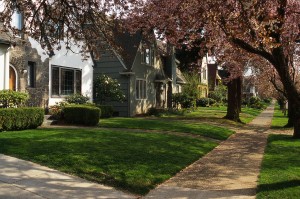Neighborhoods
adapted from a lesson plan developed by Becky Weiler, Kelly Lewis and Justin O’Toole.
 Learning Goal: Demonstrate increased ability to set goals and develop and follow thru on plans.
Learning Goal: Demonstrate increased ability to set goals and develop and follow thru on plans.
Creative Arts:
- Demonstrate the ability to represent experiences, thoughts, and ideas thru the use of visual art forms
- Represent fantasy and real-life experiences thru pretend play
- Understand and share opinions about others’ artist products and experiences.
Personal/Social: Cooperate in small and large group activities (depending on the atmosphere in which using lesson plan -community, school, and/or home activity).
Understanding ourselves, our communities, and our world:
- Will be provided varied learning opportunities that poster positive identity and an emerging sense of self and others.
- Will be provided varied opportunities and materials to learn about the community in which they live.
- Will be provided varied opportunities to develop and widen their repertoire of skills that support artistic expression, such as cutting, gluing, and caring for tools.
Objectives:
Will be able to:
- Discuss verbally the uniqueness of their neighborhood
- Design and construct their own home for the family/class neighborhood, out of a shoebox
- Design and construct in cooperative groups (or with the help of family members), a family/class neighborhood, using a variety of art materials.
- Explore and express their ideas and feelings through actively participating/playing in the family/class neighborhood.
Materials Needed: Book “Bear About Town” by Stella Blackstone
- Book “The Family Book” by Todd Parr
- Magazine pictures of different/diverse homes, neighborhoods, and families
- Large white butcher paper
- Construction paper
- Scissors, glue, craft sticks, crayons, paint, brushes, tape
- Shoeboxes
Adaptation: The project can be done in small groups.
Procedures:
Review and Introduce: Ask children and/or family members to describe their house and how their family is different? What is unique about your home? Show pictures of different types of houses and families. Read “Bear About Town.”
Adaptation: If the activity is in a family environment, you can have family members share their different perspectives i.e. our house as I see it or our family as I see it.
 Develop:
Develop:
- After reading and discussing the book, tell children/family members that they will be creating their own neighborhood and homes our of shoeboxes.
- Divide children/family members into small groups (as appropriate) to paint shoe boxes (they should already be wrapped with white butcher paper).
- In small groups (as appropriate), children/family members will paint their shoeboxes using a variety of colors.
- After children/family members have painted their boxes, explain that they will be decorating their homes and creating a family/class neighborhood.
Same-day or Next Day:
- Review with children/family members (circle time or around table) that everyone is special because we are all different (Have different families or ideas about our family, houses, communities and even look different, which makes us unique and interesting. Stress it is okay to be different!) Read “The Family Book.”
- After reading the book, tell children/family members that they will continue to work on their houses and neighborhood by decorating shoeboxes with various materials. They will also begin to color and draw grass, roads, rivers, and railroad tracks on a large piece of butcher paper (This will be bottom area of the neighborhood).
- Divide into two groups (as appropriate). One group will decorate their houses and the other will begin drawing roads, grass, rivers, etc.
- Switch activities after about 15 minutes.
 Same-day or Next Day:
Same-day or Next Day:
- Tell children/family members that they will work together to build their neighborhood. Explain that it is important to work as a team to create their community (Again stressing, that even though we are different, we can work together to build something special.)
- Have children/family members place houses on the butcher paper. If you have the supplies you can add plastic cars, trees or other items to enhance the neighborhood. You could even divide into two groups to accomplish this task (as appropriate.)
- After the neighborhood is built, have children/family members take turns exploring their neighborhood.
Close: After children/family members have had a chance to explore their neighborhood, gather everyone together and ask what they liked about the neighborhood? How is the neighborhood they built different or special?
